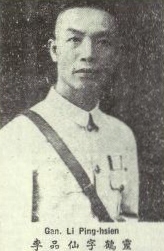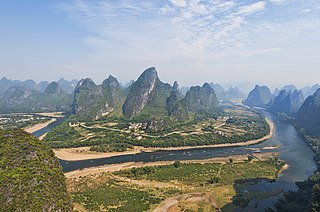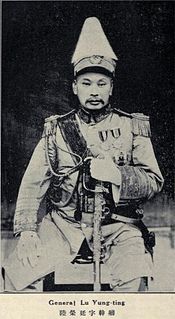
Li Zongren or Li Tsung-jen, courtesy name Delin, was a prominent Guangxi warlord and Kuomintang (KMT) military commander during the Northern Expedition, Second Sino-Japanese War and Chinese Civil War. He served as vice-president and acting President of the Republic of China under the 1947 Constitution.

Bai Chongxi was a Chinese general in the National Revolutionary Army of the Republic of China (ROC) and a prominent Chinese Nationalist leader. He was of Hui ethnicity and of the Muslim faith. From the mid-1920s to 1949, Bai and his close ally Li Zongren ruled Guangxi province as regional warlords with their own troops and considerable political autonomy. His relationship with Chiang Kai-shek was at various times antagonistic and cooperative. He and Li Zongren supported the anti-Chiang warlord alliance in the Central Plains War in 1930, then supported Chiang in the Second Sino-Japanese War and the Chinese Civil War. Bai was the first defense minister of the Republic of China from 1946-48. After losing to the Communists in 1949, he fled to Taiwan, where he died in 1966.
The Battle of Guilin–Liuzhou, also known as the Battle of Guiliu, was one of the 22 major engagements between the National Revolutionary Army (NRA) and Imperial Japanese Army (IJA) during the Second Sino-Japanese War.

Zhang FakuiCBE was a Chinese Nationalist general who fought against northern warlords, the Imperial Japanese Army and Chinese Communist forces in his military career. He served as commander-in-chief of the 8th Army Group and commander-in-chief of NRA ground force before retiring in Hong Kong in 1949.
The Constitutional Protection Movement ; pinyin: Hùfǎ yùndòng) was a series of movements led by Sun Yat-sen to resist the Beiyang government between 1917 and 1922, in which Sun established another government in Guangzhou as a result. It was known as the Third Revolution by the Kuomintang. The constitution that it intended to protect refers to the Provisional Constitution of the Republic of China.

Chen Jitang, also spelled Chen Chi-tang, was born into a Hakka Chinese family in Fangcheng, Guangxi. He joined the Chinese Revolutionary Alliance in 1908 and began serving in the Guangdong Army in 1920, rising from battalion to brigade commander. He was designated commander of the 11th Division within the 4th Army in 1925 and took up the garrison of Qinzhou City in Guangxi in 1926, thus staying in the south during the Northern Expedition. In 1928 he was made Commander of the 4th Route Army.

Chen Bingkun, ,(1868 – September 1927) was born in 1868 in Liujiang, Guangxi, China. A general in the late Qing Period, he was commander of the 1st Division of the Guangxi Provincial Army. As a supporter of the Old Guangxi Clique he became the military governor of Guangxi from 1916-17, civil governor of Guangxi in 1916 and military governor of Guangdong in 1917. With Lu Rongting he opposed the southern government led by Sun Yat-sen. In 1920 Chen Jiongming, acting for Sun Yat-sen, pushed them out of Guangdong in the First Ao-Gui War. In 1921 he invaded Guangxi, igniting the Second Ao-Gui War. Lu sent two wings of his army, one led by Tan Haoming and the other under Shen Hongying, into Guangdong where they drove back the Cantonese and occupied Qinzhou and Lianzhou. However, the center at Wuzhou, commanded by Chen Binghun, collapsed and Chen Jiongming drove up the rivers while allies came in from the north, forcing Lu Rongting to step down in July 1921. By August Chen had occupied Nanning, defeating the Old Guangxi clique and Chen Binghun. Chen died in September 1927.
The Guangdong–Guangxi War, or the 1st and 2nd Yue-Gui Wars, occurred between the Kuomintang and the Old Guangxi Clique.
After the founding of the Republic of China, Guangxi served as the base for one of the most powerful warlord cliques of China: the Old Guangxi clique. Led by Lu Rongting (陆荣廷) and others, the clique was able to take control of neighbouring Hunan and Guangdong provinces as well. The Old Guangxi clique crumbled in the early 1920s, and was replaced by the New Guangxi clique, led by Li Zongren, Huang Shaohong, and Bai Chongxi.
After the founding of the Republic of China, Guangxi served as the base for one of the most powerful warlord cliques of China: the Old Guangxi Clique. Led by Lu Rongting (陆荣廷), the clique was able to take control of neighbouring Hunan and Guangdong provinces as well. Along with the Yunnan clique, they formed the core of opposition to Yuan Shikai's monarchist ambitions during the National Protection War. With Yunnan and Sun Yat-sen's Chinese Revolutionary Party, they started the Constitutional Protection Movement. They quickly came to disagree with Sun and squeezed him out of power. Sun, Chen Jiongming, and the Yunnan clique defeated them in the Guangdong-Guangxi War. The Old Guangxi Clique crumbled in the early 1920s, and was replaced by the pro-Sun New Guangxi Clique.

Li Pinxian was a KMT general from Cangwu County, Guangxi. After the end of the Chinese Civil War in 1949, he immigrated to Taiwan.
The Yunnan–Guangxi War was a war of succession fought for control of the Chinese Nationalist Party after the death of Sun Yat-sen in 1925. It was launched by the Yunnan clique against the party leadership and the New Guangxi clique.

Li Jishen (simplified Chinese: 李济深; traditional Chinese: 李濟深; pinyin: Lǐ Jìshēn; Wade–Giles: Li3 Ch'i4-shen1; 5 November 1885 – 9 October 1959) was a Chinese military commander and statesman. He served as commander of the Fourth Army of the Republic of China, governor of Guangdong, military affairs commissioner, and acting president of the Whampoa Military Academy. After opposing Chiang Kai-shek and being expelled from the Kuomintang in 1947, he became one of the six Vice Chairmen of the Central People's Government of the People's Republic of China with that government's founding on October 1, 1949.
Events from the year 1929 in China.

Guangxi, officially the Guangxi Zhuang Autonomous Region (GZAR), is an autonomous region of the People's Republic of China, located in South China and bordering Vietnam and the Gulf of Tonkin. Formerly a province, Guangxi became an autonomous region in 1958. Its current capital is Nanning.

Lu Rongting, also spelled as Lu Yung-ting and Lu Jung-t'ing, was a late Qing/early Republican military and political leader from Wuming, Guangxi. Lu belonged to the Zhuang ethnic group.
The Second Battle of Guangzhou was fought between the rival armies of the Liangguang region in Southern China as part of the internal conflicts within the Kuomintang leading up to the Central Plains War. The previous month, the New Guangxi clique had fought the Sichuan clique at the Battle of Yichang in Hubei. The forces of the New Guangxi clique attacked Guangzhou from both their home province of Guangxi as well as Jiangxi. Guangdong forces captured a brigade commander of the New Guangxi clique's army.
The Battle of Guiping took place on June 21, 1929, and was located in the western part of Guangxi, China. It was one of the civil war battles that took place inside the National Revolutionary Army. The warring sides of Guiping's battle, one was the Li Mingrui Division of the 15th Division of the National Army, and the other was the Wei Yunsong Brigade of the New Guangxi clique.
The Chiang-Gui War was a military conflict between the Nationalist government of Chiang Kai-shek against the warlord army of Guangxi that lasted from March until June 1929. A later conflict, the 2nd Chiang Gui-War, occurred between the two opposing factions in November and December of the same year.
"Main Campaign Table of Chinese Modern Military History" edited by the National Defense University of the Republic of China








